
Wine Culture and Information since 2002 - Volume 22
 Wine Culture and Information since 2002 - Volume 22 |
|
Issue 23, October 2004 |
Contents |
|
|
New Year, New Vintage |
|
Summertime is now over leaving the memory of the many torrid days and few rainy days, at least here in Italy. After two not truly amazing years, according to an enological point of view, as it was already predicted and as it was confirmed by glasses, it seems this year will finally be a good one and that meteorological conditions have been such to expect a good harvesting and vintage 2004 in Italy. By the time you are reading these words, most of the wineries will be done harvesting grapes in their vineyards. The result of the harvest will already be in the cellars in order to begin the “tumultuous” journey that from fermentation leads to the creation of wine: a miracle which is always enchanting and that every year promises new emotions, good ones and bad ones. Comments that “experts of the field” told about vintage 2004 seems to be encouraging and promising, so good that many of them said 2004 will be as good as 2001, indisputably one of the best in recent years. Moreover, many have said that 2004 will be even comparable to the almost “legendary” 1997, that in many areas of Italy was capable of giving wine of excellent quality. Premises and comparisons apart, one thing we can be relatively certain about vintage 2004 is that it will be better than 2003 and 2002, two vintages that will not certainly be remembered for the quality of their wines, with our respect for the hard works of those who every year make wine and believe in their land. After all the good part of wine is also that: every year there is a new match and only at the end you know about the result, which is always different and always new, luckily. In Italy the 2002 was certainly not excellent, things got better in 2003, however both years - talking in general terms, of course - have not been that good and they will probably not be the ones we will remember with pleasure in future. Of course, not all the wine produced in 2002 and in 2003 is to be forgotten or underrated. If we consider things according to a more specific point of view, in which we do not consider the uneven law of generalization and we examine the results of regions, or even better small areas, it is possible to find some good bottles in these two vintages. In other words, for every vintage it is always appropriate to consider each area and each producer. They can be expressed general judgments representing the result of each vintage, but this could be unjust for those areas in which mother nature was not cruel and malevolent like in others. Generalization can always make innocent victims or can emphasize something which had no particular merits. This is the case of 1997 in which many have speculated on the extraordinary results of many areas and producers, indeed it is commonly known that whether in certain areas the results have been excellent, in others have simply been good or very good, however not excellent. Still today it is enough to say a wine is vintage 1997 and it is considered exceptional, even without considering other parameters or factors: it is 1997, it must be exceptional anyway. The same is true, in the opposite, for vintage 2002 and - in a lesser extent - for 2003. Wines belonging to these two vintages are considered inferior without even pouring them in a glass. Indeed we known, just because we poured these wines in our glasses, there was something good to be saved, both in 2002 and in 2003. Indisputably, with wines of vintage 2001 it is easier to find a higher quantity of good bottles. We should probably need to learn to listen more what a wine can tell from the glass - just like we should do in relationships with people - with no prejudices. We have to learn to express our judgment only after we completely know a wine, after having tasted it and allowed it to tell us its story. Of course there will be wines capable of telling more enchanting and exciting stories than others, this does not mean however other stories are not worth listening or not important. Moreover, whoever consider himself or herself a real wine lover or wine taster, knows the educational and cultural value of tasting average quality wines belonging to different vintages. Only this let us to appreciate and recognize the best things from the bad ones. After all it can be recognized only what is already known, they can be evaluated only things that can be compared one each other: a process which is possible only by knowing different things, those things - as a matter of fact - which represent the reference parameters for every taster. As for 2004, let's take all the prediction as a good wish in the hope they will be confirmed with results. In case it will be like this, this is for sure, the first ones to be happy for will certainly be wine lovers who - with not doubt - will share their joy with wine producers. For the moment we have to trustfully wait - like always - the ones who every year harvest the fruit of their vineyards and make it into wine: we know they will be capable of making the very best they can with what nature gives them. Of course, sometimes in the cellar can be made real miracles and from low quality grapes they can make unhoped results, not certainly extraordinary but however acceptable. It seems this year things will totally go different from the past years and - at least in the premises - we should have very good wines from every region of Italy and that will make us forget about the recent vintages and remember the very good vintage 2001. We just have to wait… while crossing our fingers.
|
||||
MailBox |
|
In this column are published our reader's mail. If you have any comment or any
question or just want to express your opinion about wine, send your letters to
our editorial or fill in
the form available at
our site.
|
| When is the best time for the grapes to be harvested in the Saar region? |
| Keith Pitcher -- Cambridge, England |
| The Saar region - belonging to the German quality wine area Mosel-Saar-Ruwer - is a pretty cold area and not all the years there are meteorological and climatic conditions which allow grape to reach full ripeness. In these least favorable years, grapes of the Saar region are mainly used for the production of Sekt, the renowned German sparkling wine. In the best years, that is the ones in which climatic conditions allow grapes to reach full ripeness, wines produced in this area can certainly be considered the best ones of Germany. Telling what is the best time for grapes to be harvested in the Saar region is pretty hard - and the same consideration can be done for any other wine area of the world - because the harvesting time is always and scrupulously decided by agronomists and wine makers according to the level of ripeness of grapes, a condition which mainly depends by the meteorological condition of each year and that every year is always different. Things get “harder” in Germany, because the highest quality level (Qualitätswein mit Prädikat, QmP) classifies wines according to the level of ripeness of grapes and to the quantity of sugar they contain. The riper the grapes, the later the harvest will be in regard to the “normal” times - usually at the end of summertime and the beginning of autumn - up to wintertime for grapes to be used for the production of eiswein. |
| I would like to know why certain sparkling wines are defined as “millesime”. |
| Mauro Pedrini -- Brescia (Italy) |
| The term “millesime” - which can be used with any other thing, not only with wines or sparkling wines - indicates, in our specific case, a wine or a sparkling wine in whose label is stated the millesime, that is the year of vintage. Whereas in “still” wines this term is scarcely used - in favor of year or vintage - in sparkling wines, in particular the ones produced with the classic method, it is often used to identify the name of a specific products, such as Franciacorta Satèn Millesime followed by the year of vintage. In millesime sparkling wines and regulated by strict disciplinary - such as Franciacorta and Champagne - grapes used for the production of the base wine must exclusively come from the vintage indicated by the millesime. Sparkling wines having no millesime, for which this term cannot be used in the label, can also be defined as sans année - abbreviated as S.A. - or non vintage, abbreviated as N.V. Other terms used for millesime sparkling wines include millesimato and vintage. |
Jerez (Sherry)Produced in Andalusia, Jerez - or Sherry - is an extraordinary wine which in past times was considered among the best ones of the world, a masterpiece of wine making art rich and enchanting |
|
In case we should tell the most complex wines to make, those requiring the mastery of talented wine makers, as well as the patient work of time and the invaluable contribution of the nature of a place, one of the first wines to mention would certainly be Jerez. No matter it is extremely difficult to make, and capable of giving emotions like few others, this wine - known in English speaking countries as Sherry and in France as Xérès - today it is probably one of the most underrated wines of the world, a condition it unfortunately shares with all fortified wines. Nevertheless a glass of this extraordinary wine, or better a copita, in case we want to use a Spanish word, as a tribute to the homeland of this great wine, always offers lots of pleasing emotions and to the nose of the connoisseur an extraordinary olfactory experience which can be hardly found in other wines. Despite of this, facts tell a truly different story and among wine lovers few of them seek or appreciate fortified wines, including Jerez. Jerez is named after the homonymous city of Jerez de la Frontera, located in Andalusia, in the southern part of Spain and near the Strait of Gibraltar. It seems Phoenicians introduced vine in Spain and at Roman times wines of this country were already well known and appreciated, as witnessed by the writings of Pliny the Elder in his monumental Naturalis Historia and of Lucio Columella - who was born in Cádiz, not far from Jerez - in his De Re Rustica. Jerez wine has always known a very high fame outside Spain and since the half of fourteenth century there are documents which prove huge exports, annotated in trade books with the term saca. They were two words of Arab origins - saca and Xeris - to give origin to the term still used in England to refer to this wine: Sherry. It seems it was William Shakespeare to “invent” the term sherris sack - a clear Anglicization of the two Arab terms - that will soon become Sherry.
The interest Englishmen had for this wine has always been very high, so high that many families moved to Spain both for beginning flourishing trade businesses with their mother land, as well as for establishing wineries for the production of Jerez, an event this wine shares with other great fortified wines: Port, Marsala and Madeira. Englishmen were not the only ones who moved to Jerez de la Frontera and working on the local wine trade, even French, Scottish, Irish and Dutch businessmen did the same. The interest of these businessmen greatly contributed to the spreading and development of Jerez and still today some of the most important Jerez wineries - called bodegas in Spanish - are owned by the European families who moved in this region. The area of Jerez de la Frontera is also famous for other two excellent products: brandy and vinegar. At Jerez the distillation of wine is an activity having a double importance: it is fundamental for the production of the excellent brandy as well as for the fortification of Jerez wine. Vinegar of Jerez is made with the wine which during the many phases of production is affected by acetic bacteria and therefore it cannot be used for making wine. Vinegar of Jerez is aged with the Solera y Criaderas system, the same used for the production of wine and of brandy.
|
||||||||
|
Jerez - Sherry or Xérès, as it is generally known outside of its homeland, was the first wine in Spain to which was conferred the Denominación de Origen - abbreviated as DO - whose area is delimited by the territories of the communes of Jerez de la Frontera, Sanlúcar de Barrameda and El Puerto de Santa María. The climate of this area is strongly affected by the influence of the Atlantic ocean and by the rivers Rio Guadalquivir and Rio Guadalete. Grapes cultivated in this area and used for the production of Jerez are three and precisely Palomino, Pedro Ximénez and Muscatel. Of the three, Palomino is the most important one, considered the Jerez grape par excellence. Palomino is a white berried grape - just like the other two varieties - with a thin skin and clusters of average size and the white wine tables produced with this grape do not have truly interesting organoleptic characteristics: it will be the particular method of production of Jerez that will transform Palomino into an extraordinary wine rich in complex organoleptic qualities. The area of Jerez in which is being cultivated the vine is classified according to the percentage of calcium carbonate found in the soil, the typical and appreciated soil made of chalky sediments, a characteristic Jerez shares with Champagne. The best grapes for the production of Jerez comes from vineyards whose soil is rich in chalky sediments, very porous and capable of keeping water and air, while forcing the vine to extend its roots very deep. The types of soils classified in the area are four:
|
|
Jerez is a very complex wine, not only in its production, but also in its classification. The wide range of Jerez styles goes beyond the simple definition of fortified wine, in fact these wines are classified according to their sweetness and - more important - according to the family they belong to. All Jerez wines are classified according to two main categories: fino and oloroso. Jerez finos are more delicate and with a pale color, dry and with appreciable acidity, whereas Jerez olorosos are more robust, with darker colors, and are produced both as dry and sweet. In these two categories are being grouped seven different styles of Jerez and the sweetness of these wines generally is a precise choice of each producer, therefore increasing - as a matter of fact - the range of Jerez styles. Jerez wines belonging to the fino category are: Manzanilla, Fino and Amontillado; whereas in the oloroso category there are: Oloroso, Cream and Pedro Ximénez. There is also another style, Palo Cortado, by many considered as a member of the fino family, whereas for others it makes its own category because its characteristics reminds both the ones of fino and oloroso.
|
|
Everything begins with the harvest and grapes are sent to the winery in order to start the production of wine. Palomino grape is pressed and the free run juice is fermented in steel or concrete tanks in order to make wine, just like any other white. At this point the producer, for each production batch, will make a decision, that to choose the destination of a wine for the production of fino or oloroso: this phase is called first classification. A choice, apparently simple, which is determined by the organoleptic qualities of the wine while trying to understand its development and its best destination. Wines destined for the production of fino are fortified with alcohol up to 15%, whereas the ones which will become oloroso will be fortified at 18%. Wines are now transferred in casks and allowed to age for their first year. This new wines are called añada, that is wines of the year, or sobretablas. The cask is filled only four fifths of its volume and the bung is not completely sealed. In this way the oxygen will enter the cask while allowing the evolution of wine. Wines which are not considered suited for the production of fino and oloroso, are destined to the production of vinegar of Jerez or distilled in order to obtain alcohol to be used for the fortification or the making of brandy.
|
|
After about one month they have been transferred in a cask, in the surface of wines destined for the production of fino takes place the most important event for their development: the formation of the so called flor, that is the most important factor responsible for the complexity of Jerez fino. It is a spontaneous formation of a layer of microorganisms belonging to the saccharomyces family, which is technically called velo (veil). This precious layer of microorganisms is formed only in presence of particular conditions: the alcoholic percentage in wine must not be higher than 15%, the temperature must be constant between 18° and 22°C (64°-71°F), an optimal surface of contact of the wine with air, usually obtained by filling a 600 liters cask with 500 liters of wine. This microorganisms are fed with some components of the wine therefore changing its composition while shielding it from the effects of oxygen. The flor quickly develops on the surface of the wine and after about one month the wine is completely covered by this thick white layer of microorganisms, however its thickness varies according to the season and humidity. The protective action of flor against oxygen is not perfect and this allows the wine to slowly oxidize, while favoring the development of its organoleptic characters and the changes done by the flor. This layer of saccharomyces will be present in Jerez fino for the whole aging cycle and it develops only thanks to the particular climatic condition of the area. Researchers have discovered that in case the flor is moved from the area of Jerez to other places of the world, it rapidly changes its characteristics or dies, a characteristic which makes Jerez fino even more special. Manzanilla is a Jerez fino exclusively produced at Salúcar de Barrameda, a city located in the Atlantic coast. Even the production of Manzanilla depends on the formation of flor, however the fundamental factor is represented by the climate - different from the inland area where Jerez de la Frontera is located - more humid and maritime which gives the wine its character while allowing the flor to constantly cover the surface. Jerez Amontillado is produced by fortifying a fino and to its subsequent aging. The higher percentage of alcohol will not allow the development of the flor and therefore the wine will get a higher structure, color and oxidation. Amontillados that with time develop the typical character of Olorosos will be classified as Palo Cortado.
|
||||
|
The main difference between Jerez fino and oloroso consists in the presence or absence of the flor, the precious veil which is formed on the surface of wine. The flor, just like any other species of yeast, cannot survive in environments in which the alcoholic percentage is greater than 16.4%: for this reason olorosos are being fortified at 18% in order to prevent its formation. Today the production of olorosos is practically forced and not left to the “case” by waiting the natural evolution of the fermented wines. Olorosos are intentionally produced with free run juice and must produced by pressing grapes in order to extract a small quantity of tannins that will give the wine a higher structure. Olorosos usually spend a longer time in the solera y criaderas than finos, in order to give the wine a higher structure and organoleptic complexity which typically reminds dried fruit. At the time of bottling, when it is being drawn off from the solera, the oloroso is a very dry wine. At this point the producer decides whether to leave it “natural” or to sweeten it by adding a small quantity of concentrated Pedro Ximénez juice, as well as Muscatel, therefore obtaining a demi-sec oloroso (abocados). In case the presence of Pedro Ximénez represents about 15%, oloroso is classified as Cream. Jerez Pedro Ximénez is produced by using the homonymous grapes dried under the sun for two or three weeks in order to allow the concentration of sugar. The must of these grapes ferment very slowly and partially and then it is fortified: the result is a thick wine, syrupy and very sweet.
|
|
No matter the style - fino or oloroso - all Jerez wines are aged by using the solera y criaderas method. This method, despite the fact it has been always in use at Jerez, is also used for the production of other fortified wines - such as Marsala - as well as some distillates, such as certain brandies. The system consists in keeping the qualities and character of the wine or the distillate constant over the time; in fact products aged with this system never have the year of the vintage written in the label. The solera y criaderas method is based on the principle the youngest wine is enriched with the character and qualities of the eldest ones. In practical terms, the system consists in a series of casks, each one of them called escala, containing the wine of an average age, and the eldest escala is called solera, because when the escalas are stacked one upon the other, this is the lowest one and in contact with the soil (suelo in Spanish). The escalas above the solera are called criaderas. The number of escalas vary according to the type of Jerez to be made, usually from a number of five to even fourteen. Every year the wine contained in the solera is being drawn off - an operation called saca - and then bottled. The part of the wine drawn off is replaced by the wine of the first criadera, this one with the wine of the second criadera, and so on, up to the last criadera. The wine of the last criadera is replaced by the wines of the sobretablas. The refilling operations are called rocio. The skill of the wineries is to do the saca and rocio operations in small quantities in order not to compromise the quality and the characteristics of the whole system, result of an uninterrupted process of even centuries. According to the law, every year can be drawn off from the solera not more than 30% of its volume.
|
Syrah - ShirazTwo names for the same grape, capable of giving great wines, longeval, complex, dense and rich in personality, two names mainly bound to two wine areas having two different enological styles |
|
Syrah or Shiraz - name with which this grape is known in Australia and South Africa - belongs to the numerous group of the so called “international” grapes and today it is virtually present in every wine country of the world. Thanks to its wide spreading and notoriety, every wine lover as he or she hears talking about Syrah or Shiraz, this brings up to his or her imagination two specific places of the world: Rhône Valley in France and Australia. Syrah is found in other wine country of the world as well - such as California, Italy and South Africa - however the reference areas of this grape are still considered France and Australia, each one of them being identifiable for its particular style. Of course, of the two countries, the one having a longer tradition is the Rhône Valley, whereas in Australia Syrah - or Shiraz, as it is commonly known in the land of kangaroos - has a history shorter than two centuries. Syrah is considered one of the most noble grapes, a fact which is clearly confirmed by the best wines produced with this grape. The origin of Syrah is pretty uncertain, however the most recurrent hypothesis support the idea it is from the Middle East. Whether its origins are still uncertain, we can however be certain that Syrah was already cultivated and used for the production of wines in the Rhône Valley since Roman times. In the Rhône Valley are still produced extraordinary wines with Syrah, considered as indisputable reference points for worldwide enology. Names of famous areas in the Rhône Valley such as Hermitage, Crozes-Hermitage, Côte-Rôtie and Cornas, bring up the image of excellent wines in every wine lover. Syrah is also known for its typical aroma of black pepper, a characteristic that in this grape - when cultivated with quality standards and in particular areas or climatic conditions - is so evident which is practically impossible not to notice among its rich quantity of aromas.
The history of Syrah in Australia is more recent and it seems it was introduced in this country by James Busby in 1837 importing some plants of this vine from Montpellier (France). In the beginning the grape was known in Australia with the name Syrah, but it soon became Scyras and then changed into the current Shiraz. With the same name the grape is also known in South Africa. The spreading of Syrah in Australia was pretty rapid and it quickly become the most cultivated vine in New South Wales. Today Shiraz is the most common red berried grape in Australia and in the course of the years, the producers of this country have been successful in creating a pretty personal style which is often more famous than the Syrah produced in the Rhône Valley, the homeland of this grape. The success of Australia Shiraz is such that today most of the wine lovers call this grape with the Australian term instead of the original Syrah. The differences between French Syrah and Australian Shiraz are not only determined - of course - by the environmental and climatic diversities of the two places - essential factors however contributing to the personality of a wine - but also to the wine making styles adopted in the two countries. In France, and in particular in the Rhône Valley, Syrah is in most of the cases vinified as a varietal wine, rarely adding Viognier, whereas in Australia this grape, besides being vinified as varietal, is often blended to Cabernet Sauvignon, another famous international grape. It should however be observed that in southern France - and in particular in the Languedoc-Roussillon, Syrah is usually blended to Grenache Noir, Mourvèdre and Cinsaut. When it is vinified as a varietal wine, Syrah from the Rhône Valley tends to develop aromas which directly remind black pepper - a characteristic which usually identifies wines produced in this area - and spices in general, whereas in Australia they usually have aromas and flavors of ripe fruit and jam as well as chocolate. Despite ampelographers identify Syrah in only one variety, many viticulturists in the Rhône Valley support the hypothesis of the existence of two distinct types, capable of producing wines with different organoleptic qualities. They believe Syrah can be classified in two varieties depending on the size of berries: Petite Syrah, with small berries and considered the best one, and Grosse Syrah, with larger berries and a lesser concentration of phenolic substances. It should be however observed this Petite Syrah, as well as Syrah, has no varietal connection with the Petite Sirah known in North and South America. Syrah is a grape which easily tends to overproduction and in this case, just like Merlot, it makes wines with pale colors and pretty neutral flavors. The production of quality wines with Syrah grape therefore requires very strict cultural standards and, in particular, low yields per hectare. Syrah is a relatively late ripening grape, it develops in pretty compact bunches with oblong dark colored berries. It needs a warm climate in order to reach full ripeness, however even in cooler climates, in which grapes do not reach full ripeness, it can produce wines with interesting aromas. Syrah tends to rapidly lose its best qualities when the yields are pretty high and in case it was left in the vine too long, it rapidly lose acidity and aromatic qualities, in particular its typical black peppery aroma. The berries of this grape contain high quantities of pigments and polyphenolic substances - a quality easily recognizable in the color and transparency of its wines - which makes Syrah very suited for the production of wines to be aged in cask for long times. Wines produced with Syrah are pretty longeval and the aging in bottle can also go from a period of 4 years for low quality wines, to 15-18 years for high quality wines.
|
||||||||
|
Because of the high quantity of pigments, the color of wines produced with Syrah grape is usually pretty dark and intense, with a very reduced transparency. This is true for wines produced with grapes coming from very low yields harvests, whereas when yields are excessive, the color in Syrah wines are pretty pale and the transparency is moderate, just like Merlot. In Syrah produced with quality standards, transparency can even be absent, almost impenetrable to light. Syrah is a pretty longeval wine and, in best cases, it can also stand to more than 15 years. During its youth Syrah will show evident purple nuances, a characteristic which is frequently found after one year of aging when the wine can be considered as “ready”. The evolution is similar to other red wines produced with grapes rich in pigments and even when it can be considered “mature”, Syrah will show an intense and deep ruby red color with nuances of garnet red.
|
|
The aromatic composition of Syrah is pretty rich and, more than other grapes, it is strongly affected by environmental, cultural and climatic conditions. The first distinction should be made for Syrah produced in Europe - and in particular in France - and Syrah produced in the so called “New World”. Syrah wines produced in Europe are usually characterized by more or less accentuated aromas of black pepper, a quality which is attenuated in wines from the New World in which it is common the aroma of ripe fruit and jams. Another characteristic of Syrah is represented by the “wood” factor and by the aging in cask. Syrah wines produced with ripe grapes the impact of typical toasted aromas of wood will be more evident than in those produced with not fully ripe grapes. When it is produced in cool climate areas or with grapes not fully ripe, Syrah develops aromas of black currant, cherry, blueberry, raspberry, violet, mint and white pepper, and very frequently the aroma of green olive as well. Wines produced in warm climate areas or with ripe grapes, develop aromas of black berried fruits, such as blackberry, plum, black currant, black cherry and violet as well as its typical aromas of black pepper, licorice and frequently hints of smoky. To these aromas are also included the ones of the same fruit jams. With time Syrah - a wine which has interesting potentialities of aging in bottle and of organoleptic evolution - develop pretty complex aromas in which will be perceived clear jammy aromas that will then evolve as game, leather, coffee, burnt rubber, caramelized sugar, raisin and tar.
|
||||
|
Even for taste, just like for aromas, it is necessary to make distinctions among Syrah wines produced in the Rhône Valley, Syrah made in Europe and those produced in Australia and in the New World. The French style of the Rhône Valley favors the production of elegant and refined Syrah, robust, with round flavors and less tannic. In Australia is favored a denser style, full bodied, concentrated and rich. In the rest of Europe can be found styles that could be defined as in-between, inspired to one or the other category. Syrah is a grape with a moderate quantity of acid, however in certain cases it can be clearly perceivable. The most common production style favors alcoholic percentages from moderate to high, even 14-15%. Its content in polyphenols is pretty high and therefore astringency will be a predominant factor in wines produced with this grape. Despite the aging in cask will contribute to smooth the astringency of Syrah, this organoleptic quality will however be a primary characteristic for this grape.
|
|
The northern part of the Rhône Valley, in France, remains one of the indisputable reference points for the production of wines made with Syrah grape. The best examples of varietal Syrah, no matter a small percentage of Viognier is allowed, are the ones produced with the appellations Hermitage, Côte-Rôtie, Cornas, St-Joseph and Crozes-Hermitage. Wines produced in these areas have pretty strong fruit aromas, a good acidity, dry and are characterized by the typical aroma of black pepper as well as an appreciable mineral taste. Hermitage has a deep color and intense fruit aromas, in particular black currant, full body and evident astringency. Côte-Rôtie generally has a paler color, more complex aromas which can also remind smoky and a less tannic flavor. Quality Cornas - very rare to find - have deep colors, a strong aroma of black pepper and a tannic flavors. Crozes-Hermitage and St-Joseph wines represent lighter versions but however interesting. Syrah is also common in the southern part of Rhône Valley and it is used in Châteauneuf-du-Pape wines and in other wines of this area, and as frequently happens in wines produced in south France, it is blended with other grapes. In Italy Syrah is pretty common and good results have been produced both in Tuscany and Sicily. In Switzerland it is interesting the Syrah produced in the Valais area and in Spain the one produced in the Toledo area. In the so called “New World”, Australia is the most renowned representative for wines produced with Syrah, or Shiraz, as it is known in this country. Here the style is denser, richer and more concentrated as opposed to the styles made in Europe. Examples of reference Syrah wines produced in Australia mainly come from the southern part and in particular from the areas of McLaren Vale, Barossa and Coonawarra. The styles of these three areas are pretty distinctive: Syrah wines from McLaren Vale are very dense and concentrated; the ones from Barossa are pretty similar although adding a touch of elegance to concentration; those from Coonawarra, because of a cooler climate, develop aromas of mint and black pepper. Other interesting areas in Australia in which it is produced Shiraz are the Victoria (Yarra Valley, Grampians and Pyrenees), New South Wales (Hunter Valley, Mudgee) as well as some areas in Western Australia. In California the Syrah is not very common, however it is catching the attention of many producers. The most interesting example of California are from the coolest areas of Edna, Santa Ynez, Santa Maria Valleys, Carneros and Mendocino. Other areas in which are being produced wines with Syrah grape include South Africa - here known as Shiraz - Washington state, Chile, Argentina and New Zealand.
|
Wines of the Month |
|
|
|
Score legend Prices are to be considered as indicative. Prices may vary according to the country or the shop where wines are bought |

|
|
COF Ribolla Gialla 2003 |
|
| Teresa Raiz (Italy) | |
| Grapes: Ribolla Gialla | |
| Price: € 8,94 | Score: |
| The wine shows a brilliant greenish yellow color and nuances of greenish yellow, very transparent. The nose reveals intense, clean, pleasing and refined aromas which start with hints of pineapple and pear followed by aromas of banana, broom, peach, plum, apple and hints of mineral and elder. In the mouth has good correspondence to the nose, a crisp attack and however balanced by alcohol, good body, intense flavors, agreeable. The finish is persistent with flavors of peach, plum and pineapple. This wine ages for at least 6 months in steel tanks and for at least one month in bottle. | |
| Food Match: Broiled fish, Fried fish, Pasta and risotto with fish and crustaceans | |
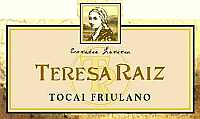
|
|
COF Tocai Friulano 2003 |
|
| Teresa Raiz (Italy) | |
| Grapes: Tocai Friulano | |
| Price: € 8,38 | Score: |
| This wine shows a brilliant greenish yellow color and nuances of greenish yellow, very transparent. The nose denotes intense, clean, pleasing and refined aromas which start with hints of pineapple, pear and hawthorn followed by aromas of banana, broom, almond, apple, peach, plum and hints of mineral. In the mouth has good correspondence to the nose, a crisp attack and however balanced by alcohol, good body, intense flavors, agreeable. The finish is persistent with flavors of pear, pineapple and peach. This wine ages for at least 6 months in steel tanks and for at least one month in bottle. | |
| Food Match: Mushroom and vegetables soups, Pasta and risotto with fish and vegetables, Sauteed meat | |
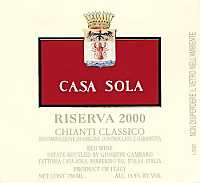
|
|
Chianti Classico Casa Sola Riserva 2000 |
|
| Fattoria Casa Sola (Italy) | |
| Grapes: Sangiovese (90%), Cabernet Sauvignon (7%), Merlot (3%) | |
| Price: € 18,00 | Score: |
| This Chianti shows a brilliant ruby red color and nuances of garnet red, moderate transparency. The nose reveals intense, clean, pleasing and refined aromas that start with hints of black cherry, violet and raspberry followed by aromas of plum, blueberry, licorice, vanilla and menthol. In the mouth has good correspondence to the nose, a slightly tannic attack and however balanced, good body, intense flavors, good tannins, agreeable. The finish is persistent with flavors of plum, black cherry and blueberry. This Chianti ages for 24 months in cask. | |
| Food Match: Roasted meat, Stewed meat, Broiled meat, Hard cheese | |

|
|
Montarsiccio 1999 |
|
| Fattoria Casa Sola (Italy) | |
| Grapes: Cabernet Sauvignon (60%), Sangiovese (30%), Merlot (10%) | |
| Price: € 20,00 | Score: |
| The wine shows a brilliant ruby red color and nuances of garnet red, moderate transparency. The nose reveals intense, clean, pleasing and refined aromas which start with hints of black cherry, plum and violet followed by aromas of blueberry, blackberry, licorice, tobacco and vanilla. In the mouth has good correspondence to the nose, a slightly tannic attack and pleasing roundness, however balanced by alcohol, good body, intense flavors, good tannins, agreeable. The finish is persistent with flavors of black cherry, plum and blueberry. Montarsiccio ages for 24 months in barrique. | |
| Food Match: Roasted meat, Stewed meat with mushrooms, Hard cheese | |
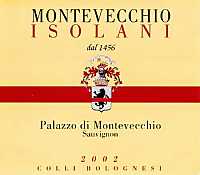
|
|
Colli Bolognesi Sauvignon Palazzo di Montevecchio 2002 |
|
| Montevecchio Isolani (Italy) | |
| Grapes: Sauvignon Blanc | |
| Price: € 7,10 | Score: |
| This wine shows an intense greenish yellow color and nuances of greenish yellow, very transparent. The nose denotes intense, clean, pleasing and refined aromas which start with hints of toasted wood, peach and broom followed by aromas of pineapple, hawthorn, pear, elder, plum and grapefruit. In the mouth has good correspondence to the nose, a crisp attack and pleasing roundness, however balanced, good body, intense flavors. The finish is persistent with flavors of peach, pineapple and plum. This wine ages for 6 months in barrique and for at least 6 months in bottle. | |
| Food Match: Mushroom and vegetables soups, Pasta and risotto with fish and crustaceans, Broiled fish | |
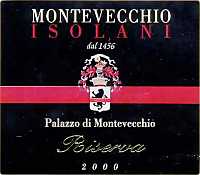
|
|
Colli Bolognesi Cabernet Sauvignon Riserva Palazzo di Montevecchio 2000 |
|
| Montevecchio Isolani (Italy) | |
| Grapes: Cabernet Sauvignon | |
| Price: € 12,00 | Score: |
| This wine shows an intense ruby red color and nuances of garnet red, little transparency. The nose reveals intense, clean, pleasing and refined aromas which start with hints of black cherry, plum and vanilla followed by aromas of black currant, toasted, cinchona, violet, tobacco and licorice. In the mouth has good correspondence to the nose, a slightly tannic attack and pleasing roundness, however balanced by alcohol, good body, intense flavors, good tannins. The finish is persistent with flavors of plum, black cherry and black currant. This wine ages for three years in barrique and for 6 months in bottle. | |
| Food Match: Roasted meat, Stewed and braised meat with mushrooms, Hard cheese | |
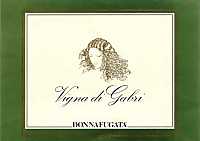
|
|
Contessa Entellina Vigna di Gabri 2003 |
|
| Donnafugata (Italy) | |
| Grapes: Ansonica (Inzolia) | |
| Price: € 9,80 | Score: |
| The wine shows a brilliant straw yellow color and nuances of greenish yellow, very transparent. The nose denotes intense, clean, pleasing and refined aromas which start with hints of plum, pear and vanilla followed by aromas of hawthorn, apple, grapefruit, banana and hints of butter, praline and almond. In the mouth has good correspondence to the nose, a crisp attack and pleasing roundness, good body, intense flavors. The finish is persistent with flavors of banana, plum and almond. A small part of this wine ferments in barrique and ages for 4 months in bottle. | |
| Food Match: Stuffed pasta, Roasted fish, Mushrooms and fish soups, Pasta with vegetables, Sauteed white meat | |
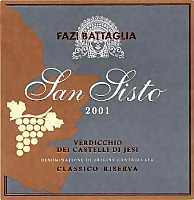
|
|
Verdicchio dei Castelli di Jesi Classico Riserva San Sisto 2001 |
|
| Fazi Battaglia (Italy) | |
| Grapes: Verdicchio | |
| Price: € 15,00 | Score: |
| This Verdicchio shows a pale golden yellow color and nuances of straw yellow, very transparent. The nose reveals good personality with intense, clean, pleasing, refined and elegant aromas which start with hints of hawthorn, vanilla and apple followed by aromas of pineapple, mango, pear, plum, almond and hints of butter and mineral. In the mouth has good correspondence to the nose, a crisp attack with pleasing roundness, however well balanced by alcohol, good body, intense flavors, agreeable. The finish is persistent with flavors of apple, plum, pear and almond. A well made wine. San Sisto ages for 12 months in barrique followed by 12 months of aging in bottle. | |
| Food Match: Mushrooms and fish soups, Pasta with fish, Roasted fish, Roasted white meat | |

|
|
Arkezia Muffo di San Sisto 2001 |
|
| Fazi Battaglia (Italy) | |
| Grapes: Verdicchio | |
| Price: € 26,00 - 500ml | Score: |
| This wine shows a pale golden yellow color and nuances of golden yellow, very transparent. The nose reveals intense, clean, pleasing, refined and elegant aromas which start with elegant hints of dried apricot, peach jam and vanilla followed by good aromas of chamomile, honey, ripe banana, candied fruit, quince jam, litchi, orange marmalade, hazelnut and hints of enamel. In the mouth has very good correspondence to the nose, a sweet and smooth attack, however well balanced, good body, intense flavors, good crispness, agreeable. The finish is persistent with long flavors of dried apricot, peach jam, honey and candied fruit. A very well made wine. Arkezia is produced with late harvested grapes affected by Botrytis Cinerea (Noble Rot), ages for 14-16 months in barrique followed by 6 months of aging in bottle. | |
| Food Match: Hard and piquant cheese, Dried fruit tarts | |
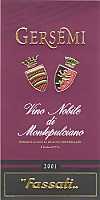
|
|
Vino Nobile di Montepulciano Gersemi 2001 |
|
| Fassati (Italy) | |
| Grapes: Sangiovese (90%), Merlot, Cabernet Sauvignon (10%) | |
| Price: € 20,00 | Score: |
| The wine shows an intense ruby red color and nuances of garnet red, little transparency. The nose reveals intense, clean, pleasing and refined aromas that start with hints of black cherry, plum and violet followed by aromas of blueberry, licorice, cinnamon, vanilla, menthol and hints of cocoa. In the mouth has good correspondence to the nose, a slightly tannic attack and however balanced by alcohol, good body, intense flavors, good tannins, agreeable. The finish is persistent with flavors of plum and black cherry. This wine ages for two years in cask followed by 10 months of aging in bottle. | |
| Food Match: Roasted meat, Braised and stewed meat, Hard cheese | |
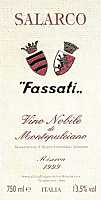
|
|
Vino Nobile di Montepulciano Riserva Salarco 1999 |
|
| Fassati (Italy) | |
| Grapes: Sangiovese | |
| Price: € 25,00 | Score: |
| This wine shows an intense ruby red color and nuances of garnet red, little transparency. The nose reveals intense, clean, pleasing and refined aromas which start with hints of plum jam and dried violet followed by aromas of black cherry, blueberry jam, carob, licorice, tobacco, vanilla and mace. In the mouth has good correspondence to the nose, a slightly tannic attack and pleasing roundness, however well balanced by alcohol, full body, intense flavors, good tannins, agreeable. The finish is persistent with flavors of plum jam and black cherry. A well made wine. This reserve ages for 3 years in cask followed by 10 months of aging in bottle. | |
| Food Match: Game, Roasted meat, Braised and stewed meat, Hard cheese | |
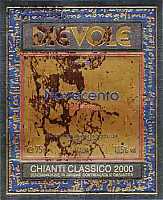
|
|
Chianti Classico Riserva Novecento 2000 |
|
| Dievole (Italy) | |
| Grapes: Sangiovese, Canaiolo Nero, Colorino, Malvasia Nera | |
| Price: € 27,00 | Score: |
| This Chianti shows a deep ruby red color and nuances of garnet red, little transparency. The nose reveals intense, clean, pleasing, refined and elegant aromas which start with hints of black cherry, plum and violet followed by good aromas of blueberry, vanilla, licorice, tobacco, cocoa, cinnamon, eucalyptus and hints of lavender and black pepper. In the mouth has good correspondence to the nose, a slightly tannic attack and pleasing roundness, however well balanced by alcohol, full body, intense flavors, good tannins, agreeable. The finish is persistent with flavors of black cherry, plum and blueberry. A very well made wine. Chianti Novecento ages in barrique for 18 months and for 6 months in bottle. | |
| Food Match: Game, Roasted meat, Braised and stewed meat, Hard cheese | |

|
|
Plenum Tertius 1999 |
|
| Dievole (Italy) Muñoz (Spain) | |
| Grapes: Sangiovese (50%), Tempranillo (50%) | |
| Price: € 29,00 | Score: |
| This wine shows an intense ruby red color and nuances of garnet red, little transparency. The nose reveals good personality with intense, clean, pleasing, refined and elegant aromas which start with hints of black cherry, violet, plum and vanilla followed by aromas of blueberry, blackberry, licorice, tobacco, earthy, eucalyptus, chocolate and cinnamon. In the mouth has good correspondence to the nose, a slightly tannic attack and however well balanced by alcohol, full body, intense flavors, good tannins, agreeable. The finish is very persistent with flavors of black cherry, plum, blackberry and blueberry. A very well made wine. Plenum Tertius ages for 6 months in bottle. | |
| Food Match: Game, Braised and stewed meat, Roasted meat, Hard cheese | |
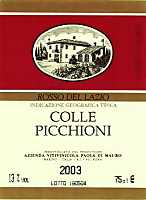
|
|
Colle Picchioni Rosso 2003 |
|
| Colle Picchioni (Italy) | |
| Grapes: Merlot, Sangiovese, Cabernet Sauvignon | |
| Price: € 9,30 | Score: |
| The wine shows an intense ruby red color and nuances of ruby red, moderate transparency. The nose denotes intense, clean and pleasing aromas which start with hints of black cherry, blueberry and plum followed by aromas of blackberry, raspberry, licorice and hints of bell pepper. In the mouth has good correspondence to the nose, a slightly tannic attack and however balanced, good body, intense flavors, good tannins. The finish is persistent with flavors of black cherry, plum and blueberry. This wine ages in steel tanks after a short period of aging in cask. | |
| Food Match: Sauteed meat, Broiled meat and barbecue, Stuffed pasta | |
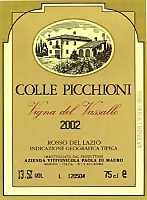
|
|
Vigna del Vassallo 2002 |
|
| Colle Picchioni (Italy) | |
| Grapes: Merlot, Cabernet Sauvignon, Cabernet Franc | |
| Price: € 21,50 | Score: |
| This wine shows a brilliant ruby red color and nuances of ruby red, moderate transparency. The nose reveals intense, clean, pleasing and refined aromas which start with hints of black cherry and blueberry followed by aromas of black currant, dried violet, plum, cocoa, licorice, tobacco and vanilla. In the mouth has good correspondence to the nose, a slightly tannic attack and however well balanced by alcohol, good body, intense flavors, good tannins. The finish is persistent with flavors of plum and black cherry. A well made wine. Vigna del Vassallo ages in barrique for about 18 months. | |
| Food Match: Roasted meat, Broiled meat and barbecue, Hard cheese | |
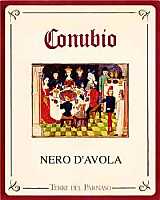
|
|
Conubio 2002 |
|
| Terre del Parnaso (Italy) | |
| Grapes: Nero d'Avola | |
| Price: € 6,00 | Score: |
| This wine shows an intense ruby red color and nuances of ruby red, moderate transparency. The nose denotes intense, clean, pleasing and refined aromas that start with hints of black cherry, raspberry and blueberry followed by aromas of blackberry, plum, black currant and licorice. In the mouth has good correspondence to the nose, a slightly tannic attack and however balanced, good body, intense flavors, good tannins. The finish is persistent with flavors of plum, blueberry and black cherry. Conubio ages for six months in steel tanks. | |
| Food Match: Sauteed meat with mushrooms, Broiled meat and barbecue, Hard cheese | |

|
|
Nekaber 2002 |
|
| Terre del Parnaso (Italy) | |
| Grapes: Nero d'Avola, Cabernet Sauvignon | |
| Price: € 9,00 | Score: |
| This wine shows a brilliant ruby red color and nuances of ruby red, moderate transparency. The nose reveals intense, clean, pleasing and refined aromas which start with hints of black cherry, plum and violet followed by aromas of blueberry, licorice, tobacco, cinnamon and vanilla. In the mouth has good correspondence to the nose, a slightly tannic attack and however balanced, good body, intense flavors, good tannins. The finish is persistent with flavors of plum and black cherry. Nekaber ages for 8 months in barrique and for 6 months in bottle. | |
| Food Match: Stewed and braised meat, Roasted meat, Broiled meat and barbecue, Hard cheese | |
Carlo PellegrinoThe historical Sicilian winery, whose name is connected to the renowned Marsala wine, although it is still committed to the production of this great wine, it is also involved in the production of table wines and sweet wines from Pantelleria |
|
Everything began more than two hundreds years ago, when an English businessman whose name is now history - John Woodhouse, son of a merchant of Liverpool - who in 1773 was forced, because of a storm, to land with his ship Elizabeth in the port of Marsala. In that occasion the young John Woodhouse drunk the wine which was produced in the area and he realized it had many similarities with other renowned and appreciated wines of those times: Jerez (Sherry), Madeira and Port. He understood he could make profits from the trading of that wine and he decided to send to his homeland England fifty pipes of 4 hectoliters each. Before shipping the wine, Woodhouse added some alcohol to the wine in order to make it more resistant to the stress of the journey and he stayed in Marsala waiting for the result. Like he predicted, the wine was successful and John Woodhouse started a profitable production of this wine and therefore writing his name in the pages of Italian enology's history. After his success, some Italian families began the production of Marsala wine, among them - and among the most important ones for the history and development of this great wine - there is Carlo Pellegrino.
Carlo Pellegrino was established in 1880 at Marsala by Paolo Pellegrino, notary and viticulturist. It was the beginning of the enterprise which led the winery to become nowadays successful worldwide with its wines. Paolo Pellegrino, with the help of his son Carlo - notary and agronomist - was successful in transforming the winery, established as a family business, and in few years become one of the most flourishing wine industries of Marsala. When his father passed away, Carlo took his place and with the help of his wife Josephine Despagne, a French gentlewoman daughter of wine maker Oscar Pierre Despagne, who brought to the winery the experience and knowledge of her family which was from Sauternes. The winery continued its expansion even in the next generations and Paolo Pellegrino, son of Carlo and Josephine, become the winery's director of management and with the help of his brother-in-law Vincenzo Alagna, they were successful in marketing their wines in the most important countries of the world. The production headquarter was expanded and in the 1930's the area occupied by the winery was increased threefold. Today Carlo Pellegrino owns three operational units, including the historical cellar in Marsala, with a total capacity of 200,000 hectoliters (of which 40,000 in oak casks), a second vinification cellar, in contrada Cardilla, downtown Marsala, with a capacity of 7,000 hectoliters. In 1992 Carlo Pellegrino winery has established a third cellar in Pantelleria island, equipped with the most modern technologies for wine making, and that allowed the revaluation of the famous wines Moscato and Passito di Pantelleria. This wines expand the production range besides the historical Marsala wines and interesting table wines produced with the “Duca di Castelmonte” branding. In the course of its history, from 1880 up to nowadays, Carlo Pellegrino winery has experienced a continuous growth up to becoming one of the most important wine industries of Sicily, not only for the production and commercialization of Marsala, but also for Pantelleria and table wines, both DOC and IGT. The winery has today 66 employees and produces more than 7,000,000 bottles per year, with an income that in 2003 reached 19 millions euros. Among the main foreign countries in which Carlo Pellegrino is present there is Great Britain, Switzerland, France, Germany, Canada, United States of America, Japan and South Korea.
As for production, Marsala wines represent 24% of total income, Pantelleria wines 20%, table wines 39%, whereas the remaining 17% is represented by Sicilian sweet wines: Zibibbo, Malvasia and Moscato liquoroso IGT. The winery systems for quality management and environmental management are respectively certified as ISO 9001/2000 and ISO 14001. The family farms occupy an area of more than 300 hectares (740 acres) in the area of Gazzerotta, Kelbi, Ramisella, Rinazzo and San Nicola “Gorghi Tondi”. Located in the most suited areas of western Sicily, these areas represent a huge richness of soils, microclimates and varieties of cultivated vines. Rinazzo is the territory in which is cultivated the Syrah grape, its soil is dry and clayey, and thanks to its particular climatic conditions, it is very suited for the cultivation of this variety. The “San Nicola” farm is located in the neighboring of Mazara del Vallo, and occupies an area of 115 hectares (280 acres), part of them being in the WWF park “Gorghi Tondi”. Its soil is made of clay and, thanks to its ideal microclimate, the area is particularly suited for Grillo and Chardonnay grapes used for the production of Gorgo Tondo Bianco wine, and for its Cabernet Sauvignon and Nero d'Avola grapes used for the production of Gorgo Tondo Rosso. The “Gazzerotta” farm, which occupies an area of about 90 hectares (220 acres) in the territory of Mazara del Vallo, is located in a territory which is included in the Delia Nivolelli DOC, one of the 19 denominations of controlled origin in Sicily. Today, in the 78 hectares (190 acres) at Gazzerotta are being successfully cultivated autochthonous and international grapes, such as Nero d'Avola, Inzolia, Grillo, Zibibbo (Muscat of Alexandria) and Malvasia Bianca, as well as Chardonnay and Cabernet Sauvignon. Carlo Pellegrino owns a modern winery in the Pantelleria island - in contrada Kuddie Rosse - in which they invested huge resources for the revaluation and the production of the famous Moscato and Passito di Pantelleria, one of the many wines who made Sicily renowned. The main winery is located in Marsala and occupies an area of about 30,000 square meters (about 7,5 acres), has an aging capacity of 200,000 hectoliters and a modern bottling line capable of producing an average of 10,500 bottles per hour. The production of this historical winery is divided into two brands: Carlo Pellegrino and Duca di Castelmonte. The Carlo Pellegrino branding is used for the renowned Marsala, sweet Sicilian IGT wines and Pantelleria DOC. The Duca di Castelmonte branding is used for all table wines as well as for sweet and fortified wines. The range of Marsala produced by Carlo Pellegrino is pretty vast and interesting. The range begins with Marsala fine - also available in the “Ruby” style - three Marsala Superiore (Dry, Garibaldi Dolce and Oro), Marsala Vergine Soleras and the interesting Marsala Vergine Vintage 1980 - exclusively produced with Grillo grape - rich of complex and strong aromas, result of more than 20 years of aging in oak casks: a wonderful Marsala perfect as a “meditation” wine and that could be served in place of a distillate. As for wines of Duca di Castelmonte branding are to be mentioned, among the many, the new and interesting red wine Tripudium, produced with Nero d'Avola, Cabernet Sauvignon and Syrah, the very good Passito di Pantelleria NES, and the enchanting grappa Moscato Passito di Pantelleria, reviewed in the “Aquavitae” column.
|
||||||||||||||||||||
|
Score legend Prices are to be considered as indicative. Prices may vary according to the country or the shop where wines are bought |
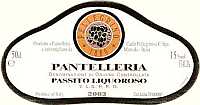
|
|
Passito di Pantelleria Liquoroso 2003 |
|
| Carlo Pellegrino (Italy) | |
| Grapes: Moscato d'Alessandria (Zibibbo) | |
| Price: € 10,60 - 500ml | Score: |
| The wine shows a pale golden yellow color and nuances of straw yellow, very transparent. The nose reveals intense, clean, pleasing and refined aromas that start with hints of grape, almond and dried fig followed by aromas of apricot jam, chamomile, date, citrus fruit peel and peach. In the mouth has good correspondence to the nose, a sweet and smooth attack, however balanced by alcohol, good body, intense flavors, agreeable. The finish is persistent with flavors of grape, apricot jam and peach. This wine ages for 2 months in bottle. | |
| Food Match: Confectionery, Almond cakes, Hard cheese | |
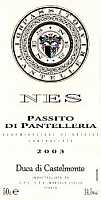
|
|
Passito di Pantelleria NES Duca di Castelmonte 2003 |
|
| Carlo Pellegrino (Italy) | |
| Grapes: Moscato d'Alessandria (Zibibbo) | |
| Price: € 23,00 - 500ml | Score: |
| This wine shows a pale amber yellow color and nuances of golden yellow, transparent. The nose reveals intense, clean, pleasing, refined and elegant aromas that start with hints of grape, orange marmalade, dried fig and candied fruit followed by aromas of dried apricot, date, peach jam, honey, lavender and hints of enamel. In the mouth has good correspondence to the nose, a sweet and round attack, however well balanced by alcohol, good body, intense flavors, agreeable. The finish is very persistent with flavors of grape, orange marmalade, dried apricot, dried fig and date. A well made wine. This passito di Pantelleria ages for 6 months in bottle. | |
| Food Match: Confectionery, Almond and fruit cakes, Hard cheese | |

|
|
Marsala Fine Ruby |
|
| Carlo Pellegrino (Italy) | |
| Grapes: Pignatello, Nerello Mascalese | |
| Price: € 8,00 | Score: |
| This Marsala shows an intense ruby red color and nuances of garnet red, little transparency. The nose denotes intense, clean and pleasing aromas which start with hints of blackberry jam and black cherry jam followed by aromas of raspberry jam , strawberry jam, dried violet, vanilla and hints of pink pepper. In the mouth has good correspondence to the nose, a slightly tannic attack, sweet and round, however balanced by alcohol, full body, intense flavors. The finish is persistent with flavors of black cherry jam, strawberry jam and blackberry jam. This Marsala Ruby ages for more than one year in cask, at least 3 months in barrique and about 4 months in bottle. | |
| Food Match: Fruit desserts, Fruit tarts, Chocolate tarts | |

|
|
Marsala Superiore Oro |
|
| Carlo Pellegrino (Italy) | |
| Grapes: Grillo, Catarratto | |
| Price: € 8,00 | Score: |
| This Marsala shows a brilliant amber yellow color and nuances of amber yellow, transparent. The nose reveals intense, clean, pleasing and refined aromas that start with hints of dried fig, caramel and the typical hint of Marsala followed by aromas of apricot jam, date, almond, citrus fruit peel and vanilla. In the mouth has good correspondence to the nose, a sweet attack, alcoholic and round, however balanced, full body, good crispness, agreeable. The finish is persistent with flavors of apricot jam, almond and dried fig. This Marsala Oro ages for more than two years in cask followed by about four months of aging in bottle. | |
| Food Match: Confectionery, Almond cakes, Hard and piquant cheese | |
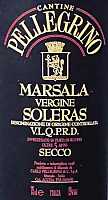
|
|
Marsala Vergine Soleras |
|
| Carlo Pellegrino (Italy) | |
| Grapes: Grillo, Catarratto, Inzolia | |
| Price: € 11,10 | Score: |
| This Marsala shows a brilliant amber yellow color and nuances of amber yellow, transparent. The nose reveals intense, clean, pleasing and refined aromas which start with the characteristic hint of Marsala, dried fig and almond followed by aromas of leather, date, dried apricot, licorice, orange marmalade, walnut and enamel. In the mouth has good correspondence to the nose, an alcoholic attack and pleasing crispness, full body, intense flavors. The finish is persistent with flavors of dried fig, almond and date. This Marsala ages for more than 5 years in cask. | |
| Food Match: Hard and piquant cheese, Almond tarts | |
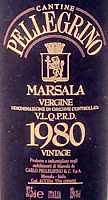
|
|
Marsala Vergine Vintage 1980 |
|
| Carlo Pellegrino (Italy) | |
| Grapes: Grillo | |
| Price: € 16,00 - 375ml | Score: |
| This Marsala shows a brilliant amber yellow color and nuances of amber yellow, transparent. The nose reveals good personality with intense, clean, pleasing, refined and elegant aromas which start with the characteristic hint of Marsala, dried fig and orange marmalade followed by aromas of leather, date, dried apricot, porcino mushroom, licorice, walnut, vanilla, almond, enamel and hints of coffee. In the mouth has good correspondence to the nose, an alcoholic and round attack, however balanced, full body, intense flavors, agreeable. The finish is persistent with flavors of dried fig, almond and coffee. A well made wine. This Marsala ages for more than twenty years in barrique followed by at least 6 months of aging in bottle. It is perfect also drunk alone or served in place of a distillate. | |
| Food Match: Hard and piquant cheese, Almond tarts | |
| Carlo Pellegrino & C. S.p.A. - Via del Fante, 39 - 91025 Marsala, Trapani (Italy) - Tel. +39 0923 719911 Fax. +39 0923 953542 - Winemaker: Gaspare Catalano (table wines), Enrico Stella (sweet and fortified wines) - Established: 1880 - Production: 7.013.000 bottles - E-Mail: info@carlopellegrino.it - WEB: www.carlopellegrino.it |
Cellar Journal |
|
This section is reserved to wine producers who want to publish news and information about their business, to announce new products or just for communicating to its customers information and promotions about their products and activity. Send news to be published at our e-mail address.
|
News |
|
In this section will be published news and information about events concerning the world of wine and food. Whoever is interested in publishing this kind of information can send us a mail at our address.
|
Production of Sweet WinesGenuine nectars of grapes, complex but gentle, harmonious and rich, sweet wines are an endless resource of aromas and flavors which have always enchanted wine lovers of every era |
|
Among the most sought wines of the world, capable of conquering the heart and soul of people, even of those who are not interested or drink wine, there are sweet wines which have always met the interest and the taste of all wine lovers in every era, from the dawn of enology up to nowadays. Noble and majestic wines, expensive and in past reserved to the ministers of cult and kings only, despite they show different colors and qualities, they all have in common the same characteristic, the one of keeping the spirit of the grape expressed in its sweetness and in its charming and enchanting aromas. The production of these wines requires a higher effort and a higher commitment to quality, a strict control which begins in the vineyard and ends in the bottle. Sweet wines are also capricious and in order to be superlative they need huge productive efforts, otherwise the finished product will be however sweet and pleasing although lacking elegance and class, in other word, of that magic touch which always surprises the senses of the ones who are capable of appreciating them and to listen to their enchanting stories.
|
|
The main organoleptic difference between “regular” wines and sweet wines consists in the quantity of sugar dissolved in wine and not transformed into alcohol by fermentation, in other words, by the so called “residual sugar”. The higher the quantity of residual sugar, the higher the sweetness. Despite in dry wines it is sometimes possible to find some residual sugar, its quantity is so low that it is not perceived by taste and therefore the wine is considered as dry. It should also remembered the organoleptic sensation of sweetness is balanced by acidity, therefore in a very crisp wine, that is with a pretty high acidity, the sweetness will be less evident, in other words, balanced. This is the case of German sweet wines - in particular Trockenbeerenauslese wines - which have pretty high quantities of residual sugar without being sickly just because of the high acidity. Even alcohol contributes to the balance of sweetness, therefore sweet wines usually have pretty high alcoholic percentages - sometimes the alcohol is also added therefore making the wine fortified - both for balancing the wine as well as for making it more stable.
As it is commonly known, alcohol in wine is produced by the fermentation of the sugar contained in the must by means of yeast. The quantity of sugar contained in the must determines the quantity of alcohol at the end of fermentation and it takes 17.5 grams of sugar per liter in order to obtain 1% of alcohol. For the production of a dry wine having an alcoholic volume of 12%, will be necessary 210 grams of sugar per liter of must. This value expresses the quantity of potential alcohol, that is the one which is obtained in case all the sugar is fermented and transformed into alcohol. In sweet wines is therefore necessary that part of the sugar is transformed (fermented) into alcohol, whereas a certain quantity must be kept in order to give sweetness to the wine. This quantity of non fermented sugar - and therefore kept - represents the residual sugar and the higher this quantity, the higher the relative perception of sweetness. In order to help to better understand this concept, let's suppose we want to make a sweet wine from a must containing 320 grams of sugar per liter. In case all the sugar should be fermented, the alcohol volume (potential alcohol) would be a slightly more than 18% (320 / 17.5 = 18.28). Let's suppose now that after having analyzed the quality of our must, we want to make, in order to have a balanced sweet wine, a finished product having 14% of alcohol. To do so we need 245 grams of sugar per liter to be transformed into alcohol (17,5 × 14 = 245) while leaving the rest of the sugar non fermented, that is residual. This residual sugar, in our case of 75 grams per liter (320 - 245 = 75), will be responsible for the perception of sweetness of the wine. Of course in this example we wanted to make things very easy, indeed the production of sweet wines is not made this way because yeast does not stop its action upon “command”, it continues fermenting sugar until the chemical conditions of the must allow it to do so, saved the case its activity is intentionally stopped. The most common way to interrupt the action of yeast is to add alcohol - that is to fortify the wine - therefore saving part of the sugar from fermentation. It should be remembered ethyl alcohol is a toxic substance and this is true for yeast as well that, in condition of high concentration of alcohol, generally about 16% and according to the species of yeast, it dies and therefore the fermentation is stopped.
|
||||||||
|
The taste in sweet wines is determined by the quantity of residual sugar, of course these wines are not “sweetness” only, a characteristic that could be obtained in many and simple ways. Sweet wines generally offer very complex aromatic qualities, however it is sweetness to be the main quality which distinguishes them. Like we already said, the quantity of residual sugar is determined by what it is left at the end of alcoholic fermentation, at least, this is what should happen in theory. There are many ways to make the quantity of residual sugar and each one of them gives extremely different results. The quality of sweetness sensation perceived in wines is not always the same: in some wines it will seem to be more genuine and harmoniously integrated to the other gustatory qualities, in others it will be perceived the sensation of an almost “forced” sweetness, it will seem this sweetness does not belong to the wine but to something extraneous and disharmonious. Despite the fact this may sound absurd, sweetness in wine, or better the way a wine expresses its sweetness, represents a factor of primary importance in determining the quality of a sweet wine, of course, including its aromas and all the other organoleptic qualities.
|
|
This method represents the most simple system - as well as the most disputable and least noble one - for the production of sweet wines and it is generally used for low quality wines. In practical terms, a dry wine produced according the normal wine making procedures is being sweetened. This method - it should be remembered - is forbidden in many wine countries of the world, whereas in other it is allowed. It should be however observed that even in countries where this is allowed, the adding of sugar to a dry wine is never done by quality producers, just because the result is very scarce and the “trick” is easily recognizable. After having produced a dry wine - and just before being bottled - it is added some sugar, it is made sure it is perfectly dissolved in the wine, then follows filtering, stabilizing and then bottling. Another method consists in adding to a dry wine a certain quantity of non fermented must - therefore rich in sugar - called sweet reserve (from the German süssreserve), properly sterilized, filtered and kept at a low temperature in order to prevent fermentation. In some fortified wines - in particular for sweet Jerez (Sherry) and in some styles of Marsala - it is added to the wine a certain quantity of concentrated must.
|
|
In the best sweet wines, sugar is never added, not even in the form of concentrated must or sweet reserve, and the effort of producers is to get out the most from the sugar contained in grapes. The best method consists in concentrating the sugar in each grape berry, a result that can be obtained in many way by subtracting water from grape juice. Finally, another common method for keeping sugar in grape juice consists in voluntarily stopping the fermentation of must by adding a certain quantity of alcohol or brandy. Each one of these methods allows the production of very different styles of wines, each one having its own characteristics and peculiarities, however they have been capable - in the course of centuries - to prove their efficiency in the production of good and high quality sweet wines. Of course these techniques alone cannot ensure a good result and high quality in wines: they simply represent one of the many quality factors that together with all the others allow the production of a great sweet wine. As it is commonly known, the development of ripeness in grapes does some chemical changes in the juice. The unripe berry is rich in acid and poor in sugar, and this conditions changes with the ripening process in which the quantity of acid diminishes whereas the sugar is increased. Therefore the riper the grape, the higher the quantity of sugar. If the grape is allowed to ripe beyond the optimal level - a condition known as overripeness - the berry begins to dry because of the loss of water with the result of obtaining a more concentrated juice and a higher quantity of sugar per liter. Using overripe grapes - that is grapes left to naturally overripe in the plant - is very common in the production of popular sweet wines, such as the ones produced in South-Western France and many Italian sweet wines. Using overripe grapes is also typical in the production of German wines - whose quality system classifies wines according to the quantity of sugar contained in grapes - and the categories of wines produced with this system are the so called Spätlese and Auslese. This system does not make use of grapes affected by the famous Botrytis Cinerea or noble rot. Botrytis Cinerea represents another method which allows the concentration of sugar in grape berries to be used for the production of sweet wines. Of all the methods this certainly is the most noble one, because the action of the rot does not only reduce the quantity of water in the grape juice, it also does extraordinary changes which will give wine elegant and complex aromas as well as an absolutely unique flavors. As the spores of Botrytis Cinerea - or noble rot - gets on the skin of the grape, they hole it in order to seek nourishment inside the berry necessary for its development. This operation - besides allowing the rot to get inside the berry - also favors the evaporation of water with the result of concentrating the juice. As soon as it is inside the berry, noble rot adds its flavors and its aromas to the grape juice - as well as other unknown components - which transform the sweet juice into a divine nectar. The development of Botrytis Cinerea needs particular environmental conditions - moisture in the morning in order to allow the development of the rot, sunny and dry afternoons in order to prevent its excessive development - and the skin of the grape must be thin enough in order to allow the spores to hole it and get into the berry. Botrytis Cinerea - despite the fact it is essential for the production of great sweet wines - represents a very risky condition for producers. When meteorological conditions are unfavorable - too much moisture or rain - its development is excessive and it irremediably compromises the grapes. Berries of botrytized grapes are very delicate and therefore harvesting is done by hand and with extreme care. Among sweet wines produced with grapes affected by Botrytis Cinerea are to be mentioned Sauternes, Barsac, Tokaji Aszú, Monbazillac, Alsatian Sélection de Grains Nobles, the so called muffati from Italy, German Beerenauslese and Trockenbeerenauslese. Because of the strong dependency on the environmental and meteorological conditions - and in particular on the risks deriving from such conditions - some producers of botrytized wines, usually Californian and Australian ones, as well as from other countries, harvest grapes, spray the spores of Botrytis Cinerea on the skin and then keep them in rooms in which are being artificially recreated environmental conditions that can favor and control the development of the rot. The result is similar - but not the same - to the wines produced with “natural” methods and this system is generally used for low quality botrytized wines. Other methods that allow the keeping of grape sugar include the one traditionally used in Italy for the so called passiti wines, that is produced with grapes allowed to dry in the plant, left in mats after harvesting or hung in sufficiently aerated rooms. In areas where the climate is warm and dry, the grape is usually allowed to dry in mats and left outside, whereas in humid areas it is necessary to properly protect the grapes in aerated rooms in order to prevent the formation of rot. With this system are being produced - among the many - Vinsanto, Recioto di Soave and della Valpolicella, Sagrantino Passito as well as the renowned Passito di Pantelleria. In cold areas, such as Germany, Austria and Canada, it is common practice to harvest the overripe grapes when they are frozen by low temperatures. The grapes are soon after pressed and it is obtained a must with very high concentration of sugar and acid, whereas the water, frozen inside the berry, is not extracted. With this method are produced the renowned German and Austrian Eiswein, as well as Canadian and American Ice Wines. Another method consists in interrupting the fermentation of the must by adding some alcohol or brandy, therefore keeping the non fermented sugar as residual. With this system are produced the renowned French Vin Doux Naturels - such as Banyuls and Muscats from Languedoc-Roussillon - as well as many sweet fortified wines, such as Port.
|
||||
|
The phases of the production of sweet wines are basically the same used for dry wines, both whites and reds. However in some wines the production procedures requires the adoption of specific practices in order to obtain the desired product, such as in case of sweet wines produced with grapes affected by Botrytis Cinerea. The grape juice obtained during the last phases of pressing is usually considered of lower quality and in the production of quality wines it is usually rejected or used for the production of ordinary wines. The opposite is true for grapes affected by noble rot, in which it is the final part of the pressing to produce the richest must, concentrated and sweet. The fermentation of a must rich in sugar is very slow and sometimes in those having a very high concentration of sugar the fermentation could not even start or however produce a small quantity of alcohol. This is the case of very sweet German Trockenbeerenauslese and Tokaji Eszencia wines in which the alcohol volume could also be lower than 6%. The interruption of fermentation - in order to keep sugar and therefore sweetness - can be done by adding alcohol to the must (fortification), as well as lowering the temperature, adding sulfur dioxide (SO2), treating the must with sterile filtering in order to completely eliminate yeast that would otherwise resume fermentation. Sweet wines - just like dry wines - can also be aged in casks in order to further favor their concentration as well as enriching them with the organoleptic qualities of wood.
|
YogurtKnown since ancient times, this simple food has many qualities which make it a precious help for the human body and a tasty ingredient for the preparation of many recipes |
|
|
|
The origins of yogurt are uncertain, the most ancient documents we know already mentions this food. Yogurt was probably consumed in the prehistorical age already, the practice of keeping liquids in goatskins, or other containers made of animal's skin or stomach, allowed the discovery of the simple production technique. The inventor of Yogurt probably was the milk itself. Milk left in contact with air, at a proper temperature, because of the effects of some bacteria, tend to coagulate and to ferment while being naturally transformed into yogurt. The lifestyle of ancient people, committed to sheep-farming and used to keep products in animal's skins and stomachs, favored the discovery of this new food: bacteria found in goatskins favored the fermentation of milk. There are many legends about the origin of yogurt. One of them has it the discoverer was a shepherd who, after having forgotten milk for some time in a goatskin, he found it changed into a more creamy and tasty product. Another legend - dated back to the eighth century - has it a Turk nomad, traveling in a mountain region between the Black Sea and Caspian Sea, was carrying a goatskin containing milk and, because of temperature and bacteria contained in the goatskin, it was transformed into a pleasing creamy beverage: yogurt. Yogurut or joggurt, which in Turk language means “thick milk”, seems to be the name from which derives the modern yogurt, in fact the origin of this name seems to be yogurut dated back, with high probability, to the eighth century. Since then yogurut, or yogur or joggurt, was consumed until the ninth century when the name changed into the term we know today: yogurt. The spreading of yogurt is so wide and it is not possible to tell the moment in which it began its spreading in the many countries. Yogurt is mentioned in the Bible and in the “One Thousand and One Nights” tales, it was used by Romans, Egyptians, Phoenicians and Greeks, it was used by Russian people, Hindu and Zulu. The Greek physician Galen mentions yogurt in his writings and he believes it has healing properties for stomach and liver. Western travelers were surprised by the longevity of Arab people living in the desert as well as of Bulgarian shepherds who used to eat yogurt in order to purify blood, bowel as well as for improving sleep. Even Mongols had yogurt in high esteem, they considered it indispensable for longevity, physical resistance and beauty. In India it is being used since immemorial times.
In order to give an example of the spreading of yogurt, here it is a list of some countries and the name with which is known: Iceland - Skyr; Japan - Yakult; Minor Asia - Leben, Laben; Scandinavia - Taette; Finland - Plimae, villi, Yugoslavia - Kysla Gravenica; Iran - Yok; Egypt - Leben, Laban; Norway - Kaelder-milk; Chile - Skuta; India - Dahi, Lassi; Burma - Tyre; South Russia - Kefir, Kuban; Central Asia - Koumiss; Angola - Kaffirs; Eastern Asia - Saya; Lapland - Taetioc; Arab countries - Leben; Hungary - Tarhò; Greece - Kajmak; Western countries - Yogurt, Yoghurt; Russia - Kumys, Kummiss. The first one to scientifically study yogurt seems to be Russian biologist Prof. Ilya Ilyich Metchnikov, researcher of the Pasteur Institute of Paris, who supported the idea in the colon of mammals could develop many harmful bacteria responsible for the development of grave diseases, in particular in subjects whose nutrition is rich of meat and do little physical activity. A regular consumption of yogurt prevents these diseases while keeping the bowel flora capable of preventing the formation of noxious bacteria. One of the merit of this professor was the discovery, in the yogurt common in the Bulgarian people known for their longevity, of the bacteria responsible for the fermentation and from that moment on it was called “Bulgarian” that is Lactobacillus Bulgaricus.
|
||||||||
|
Yogurt is a product obtained by the spontaneous acidification of milk. This process is conducted by mean of lactose scission - milk sugar - in two components, glucose and galactose, and the subsequent production of lactic acid. The process of fermentation is started by lactic ferments Lactobacillus Bulgaricus e Streptococcus Thermophilus. Lactic ferments are living monocellular organisms, and must be present naturally alive at least for 100 millions for each gram of yogurt and at least 10 millions at the moment of consumption. This rule is not strict but it derives by the fact lacto-bacteria, at the moment of production, begin to die up to their complete extinguishment. Yogurt keeps all the original fat part of milk whereas the proteinic part undergoes a partial hydrolyzation process which makes it more digestible, in other words, the acidification process leads to the division of the complex proteinic chains and to the “fine flocculation” of proteins, a process which ease the aggression of enzymes during digestion. In Yogurt, proteins of whey remain unaltered even after the fermentation, the presence of lactose and lactic acid highly favor the availability of two very important elements contained in milk: calcium and phosphor. The high acidity of yogurt helps bowel flora to contrast the many putrefactive phenomena typical of the human bowel. Moreover yogurt, by means of fermentation, gets enriched of vitamins, in particular the ones belonging to group “B”.
|
|
The process of industrial yogurt making begins with the pasteurization of milk. This process consists in heating the milk to a temperature of at least 72°C (161°F) and for at least 15 seconds, a subsequent and quick cool down at 8-18°C (46-50°F). This process destroys every noxious bacteria and unfortunately part of vitamins and calcium contained in milk as well. Anyway it is worth doing because fresh non pasteurized milk may contain harmful bacteria, and in some cases, they can be present bacteria of typhus, diphtheria and tuberculosis. For this reason it is advisable to avoid the consumption of non pasteurized milk, even though, calcium and vitamins can also be found in other foods. The preparation procedure continues by adding lactic ferments, the fermentation of the product (3-6 hours), homogenization in order to prevent the presence of fatty globules, cooling down at 4°C (39°F), adding sugar and/or cooked fruit when needed, adding natural aromas when needed as well as preservatives such as potassium sorbate (E202), packaging and commercialization. A short mention about E202 “potassium sorbate” can be useful. First of all, it is a preservative that avoids the spoilage of foods, in labels is usually found with the letter “E” (European Union) followed by its identifying number. Preservatives permitted by law goes from E200 to E299. In our specific case, potassium sorbate (E202) is an anti-mold product used in cheese, yogurt, tortellini, mayonnaise, bakery products, fats and oils, with the exception of olive oil. It is a product classified as “absolutely safe”. The preparation of homemade yogurt does not differ much from the industrial process. It begins by heating the milk until ebullition, lowering and stabilization of temperature down to 40-44°C (104-111°F), adding of the lactic ferments (that could also be in the form of yogurt as well), acidification, which usually happens within 12-24 hours, cooling down to a temperature of 4°C (39°F), keeping in refrigerator. Homemade yogurt should be consumed within a week and kept in the refrigerator at a temperature from 4 and 10°C (39-50°F).
|
||||
|
The chemical composition of yogurt varies according to the type of milk used for its production - whole cow milk, goat, sheep or other animals - to the level of skimming and any possible adding of aromatic substances or fruit. Some components directly come from the breast or blood of the animal, therefore it is of fundamental importance the milk is from a sound animal. The pasteurization process, used in the production of industrial yogurt, prevents the presence of harmful microbes, however it does not alter any noxious substance present in the animal's body. Lactic ferments responsible for fermentation mainly are Lactobacillus Bulgaricus and Streptococcus Thermophilus. Vitamins mainly found in yogurt are A, B1, B2, B6, B12, C, D e I; the main mineral salts are calcium, phosphor, potassium and sodium. Yogurt made with partially skimmed cow milk contains 88.50% of water, 3.50% of proteins, 1.80% of fats, 5.00% of sugars 49 Kcal per 100 grams. Goat yogurt contains 86.30% of water, 3.90% of proteins, 4.30% of fats, 4.70% of sugars and 72 Kcal per 100 grams. Finally, sheep yogurt contains 82.70% of water, 5.30% of proteins, 6.90% of fats, 5.20% of sugars and 103 Kcal per 100 grams.
|
|
The good properties of yogurt are now known to anyone, its particular composition makes it an ally of the digestive system thanks to its acidity, to the presence of active ferments and to the vitamins of group B. Yogurt is rich in calcium, which in the form of “calcium lactate”, helps the bowel to the assimilation of foods. Yogurt is particularly useful in the nutrition of babies and elder people as well as in case of digestion problems. Yogurt favors the synthesis of vitamins belonging to the group B, the synthesis of antibiotic substances, the deactivation of some cancerous substances, the cure for dysentery caused by bacteria, the restoration of bowel flora, the cure for constipation as well as a cure for sickness of stomach and bowel. Fats contained in yogurt are made of very small molecules, therefore easily assimilable by the organism, moreover its proteins contain essential aminoacids with anti inflammatory and immunitary properties. Milk occupies the third place (with about 16%) in the classification of products that can be cause of allergies, yogurt, thanks to its characteristics, occupies the sixteenth place (with about 1%). The efficiency of yogurt follows a natural “countdown”. Lactic ferments contained in yogurt tend, with time, to die and therefore yogurt progressively loses its efficiency. For this reason it is best to always buy yogurt as fresher as possible. Maybe it is because of this reason many consumers prefer making their own yogurt at home in order to always have a very fresh product.
|
AquavitaeReview of Grappa, Distillates and Brandy |
|
|
| Distillates are rated according to DiWineTaste's evaluation method. Please see score legend in the "Wines of the Month" section. |

|
|
Consenso Grappa Riserva |
|
| Distillerie Bonollo (Italy) | |
| Raw matter: Pomace of Sangiovese, Canaiolo Nero, Malvasia | |
| Price: € 31,00 - 500ml | Score: |
| The aspect of this grappa is limpid and crystalline with a very pale amber yellow color. The nose denotes intense, clean, pleasing and refined aromas of vanilla, licorice, hazelnut, dried plum and dried violet with almost imperceptible alcohol pungency. The taste is intense with a slight sweet hint and pleasing roundness, pretty perceptible alcohol pungency which tends to rapidly dissolve, however balanced and harmonic. The finish is persistent with pleasing sweet hint and smooth, flavors of dried plum, hazelnut and licorice. Well made. This grappa is produced by double distillation and ages in casks of acacia, oak, ash and cherry wood. Alcohol 45%. | |

|
|
Consenso Brandy Italiano 1975 |
|
| Distillerie Bonollo (Italy) | |
| Raw matter: Vino di uva Trebbiano | |
| Price: € 31,00 - 500ml | Score: |
| This brandy is limpid and crystalline with a pale amber yellow color. The nose reveals intense, clean, pleasing and refined aromas of vanilla, chocolate, licorice, tobacco, hazelnut, caramel and ripe banana with almost imperceptible alcohol pungency. In the mouth is elegant and smooth, intense, good sweet hint, pleasing roundness and alcohol pungency which rapidly get dissolved, harmonic and balanced, good correspondence to the nose. The finish is persistent with good flavors of vanilla, caramel and chocolate. Well made. This brandy is distilled with discontinuous steam alembic still and ages for 20 years in oak casks. Alcohol 43%. | |

|
|
Grappa di Moscato Passito |
|
| Carlo Pellegrino (Italy) | |
| Raw matter: Pomace of Moscato and Passito di Pantelleria | |
| Price: € 16,00 - 500ml | Score: |
| This grappa shows a brilliant amber yellow color, limpid and crystalline. The nose denotes good personality with intense, clean, pleasing and refined aromas of caramel, vanilla, praline, raisin, honey, dried fig, prunes, raspberry and date with alcohol pungency almost imperceptible. The taste is agreeable with intense flavors, good smoothness and pleasing sweet hint, alcohol in good presence without excessively disturbing balance, very agreeable. The finish is persistent with pleasing sweet and aromatic hint and good flavors of raspberry, raisin, honey and date. Very agreeable. This grappa is aged in barrique. Alcohol 40%. | |

|
|
Grappa Riserva del Conte 1987 |
|
| Castello di Spessa (Italy) | |
| Raw matter: Pomace of Conte di Spessa wine (Merlot, Cabernet Sauvignon, Cabernet Franc) | |
| Price: € 59,00 - 700ml | Score: |
| This grappa is limpid and crystalline with a deep amber yellow color. The nose reveals good personality with intense, clean, pleasing, refined and elegant aromas of vanilla, tobacco, chamomile, dried fig, caramel, hazelnut, dried plum, chocolate, coffee, ripe banana and cinnamon with almost imperceptible alcohol pungency. In the mouth is smooth and intense, elegant, with a good sweet hint well balanced by alcohol which tends to rapidly dissolve, harmonic and balanced. The finish is very persistent with a pleasing sweet hint and good flavors of vanilla, caramel, dried plum and hazelnut. Truly well made. This grappa is distilled with a discontinuous steam alembic still in small copper boilers and ages for 15 years in the barriques used for the aging of Pinot Bianco di Santarosa. Alcohol 40%. | |
Wine Parade |
|
|
| The best 15 wines according to DiWineTaste's readers. To express your best three wines send us an E-mail or fill in the form available at our WEB site. |
| Rank | Wine, Producer | |
|---|---|---|
| 1 |
| Amarone della Valpolicella Classico Capitel Monte Olmi 1999, Tedeschi (Italy) |
| 2 |
| Turriga 1998, Argiolas (Italy) |
| 3 |
| Barolo Cicala 1999, Poderi Aldo Conterno (Italy) |
| 4 |
| Rioja Reserva Era Costana 1999, Bodegas Ondarre (Spain) |
| 5 |
| Brunello di Montalcino Prime Donne 1998, Donatella Cinelli Colombini (Italy) |
| 6 |
| Montepulciano d'Abruzzo Villa Gemma 1999, Masciarelli (Italy) |
| 7 |
| Anjou 2001, Domaine de Montgilet (France) |
| 8 |
| Aglianico del Vulture La Firma 2000, Cantine del Notaio (Italy) |
| 9 |
| Riesling Cuvée Frédéric Emile 1999, Maison Trimbach (France) |
| 10 |
| Harmonium 2001, Firriato (Italy) |
| 11 |
| Pinot Noir Napa 2002, Clos du Val (USA) |
| 12 |
| Chablis Grand Cru Les Clos 2002, Domaine Billaud-Simon (France) |
| 13 |
| Franciacorta Cuvée Annamaria Clementi 1996, Ca' del Bosco (Italy) |
| 14 |
| Uncut Shiraz 2002, Gemtree Vineyards (Australia) |
| 15 |
| Alto Adige Gewürztraminer Kolbenhof 2002, Hofstätter (Italy) |
| |||||||
Privacy Policy | |||||||


| Copyright © 2002-2024 Antonello Biancalana, DiWineTaste - All rights reserved |
| All rights reserved under international copyright conventions. No part of this publication and of this WEB site may be
reproduced or utilized in any form or by any means, electronic or mechanical, without permission in writing from DiWineTaste. |